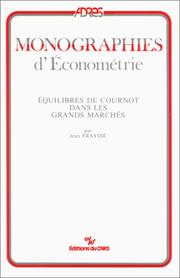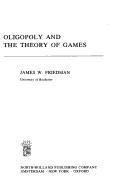| Listing 1 - 8 of 8 |
Sort by
|
Book
ISBN: 0853232202 9780853232209 Year: 1972 Publisher: Liverpool Liverpool University Press
Abstract | Keywords | Export | Availability | Bookmark
 Loading...
Loading...Choose an application
- Reference Manager
- EndNote
- RefWorks (Direct export to RefWorks)
Oligopolies --- Prisoner's dilemna game --- Mathematical models --- Oligopolies - Mathematical models
Book
ISBN: 364215963X 9786612994982 3642159648 1282994980 Year: 2010 Publisher: Heidelberg ; New York : Springer,
Abstract | Keywords | Export | Availability | Bookmark
 Loading...
Loading...Choose an application
- Reference Manager
- EndNote
- RefWorks (Direct export to RefWorks)
The book focuses classical oligopoly theory as developed in 1840-1940. By the end of this period oligopoly came under the spell of game theory in its probabilistic equilibrium format. Work by Cournot, von Stackelberg, Palander, and Hotelling, causal and dynamic in essence, but ignored, is reconsidered in the light of modern dynamics using topology and numerics. As particular features, von Stackelberg leadership is included in the dynamic Cournot model, the Hotelling problem is solved with elastic demand, thus skipping the absurd idea of quadratic transportation costs. Further, it is shown that the celebrated destabilisation of Cournot equilibrium under increased competition is due to mistakenly assuming constant returns, and that the whole idea of rational expectations is untenable in dynamic oligopoly. Early original ideas in oligopoly theory, such as coexistence and multiplicity of attractors are focused again after many undeserved decades of oblivion.
Oligopolies -- Mathematical models. --- Oligopolies. --- Management --- Business & Economics --- Industrial Management --- Management Theory --- Interorganizational relations. --- Monopolies, Partial --- Partial monopolies --- Applied mathematics. --- Engineering mathematics. --- Industrial organization. --- Economics. --- Industrial Organization. --- Applications of Mathematics. --- Intergroup relations --- Organization --- Complex organizations --- Economic concentration --- Competition, Imperfect --- Interorganizational relations

ISBN: 3718602792 9783718602797 Year: 1986 Volume: 3 Publisher: Chur Harwood
Abstract | Keywords | Export | Availability | Bookmark
 Loading...
Loading...Choose an application
- Reference Manager
- EndNote
- RefWorks (Direct export to RefWorks)
Oligopolies --- Mathematical models --- -Economic concentration --- Monopolies, Partial --- Partial monopolies --- -Site, location, place of business --- -658.112 Site, location, place of business --- 658.112 --- 658.112 Site, location, place of business --- Site, location, place of business --- Mathematical models. --- Oligopolies - Mathematical models
Book
ISBN: 3642021077 3642021050 9786612832369 1282832360 3642021069 Year: 2010 Publisher: Heidelberg : Springer,
Abstract | Keywords | Export | Availability | Bookmark
 Loading...
Loading...Choose an application
- Reference Manager
- EndNote
- RefWorks (Direct export to RefWorks)
The book focuses on the dynamics of nonlinear oligopoly models. It discusses the classical Cournot model with a large variety of demand and cost functions that illustrate the many different types of possible best response functions and it shows the existence of unique and multiple equilibria. Particular emphasis is placed on the influence of nonnegativity and capacity constraints. Dynamics are introduced under various assumptions for the adjustment process. An introduction to the analysis of global dynamics is given through some specific examples. The book also considers concave and general oligopolies and gives conditions for the local asymptotic stability of their equilibria, and it investigates global dynamics in some special cases. Other oligopolies examined include market share attraction games, labor-managed oligopolies, partially cooperating firms and models with intertemporal demand attraction. Local/global stability analyses are carried out for these models and the impact of constraints is discussed. The book contains a number of technical appendices that summarize techniques of global dynamics not easily accessible elsewhere. .
Oligopolies -- Mathematical models. --- Oligopolies. --- Oligopolies --- Management --- Business & Economics --- Economic Theory --- Industrial Management --- Mathematical models --- Mathematics. --- Mathematical models. --- Math --- Game theory. --- Statistical physics. --- Dynamical systems. --- Economic theory. --- Microeconomics. --- Industrial organization. --- Economics. --- Economic Theory/Quantitative Economics/Mathematical Methods. --- Game Theory, Economics, Social and Behav. Sciences. --- Industrial Organization. --- Statistical Physics, Dynamical Systems and Complexity. --- Science

ISBN: 222203857X 9782222038573 Year: 1986 Publisher: Paris Centre National de la Recherche Scientifique
Abstract | Keywords | Export | Availability | Bookmark
 Loading...
Loading...Choose an application
- Reference Manager
- EndNote
- RefWorks (Direct export to RefWorks)
Equilibrium (Economics) --- Equilibre (Economie politique) --- Cournot, A. A. --- Oligopolies --- Competition, Imperfect --- Mathematical models --- Mathematical models. --- AA / International- internationaal --- 380.22 --- Concurrentie. Monopolie, duopolie, oligopolie. --- Equilibrium (Economics). --- DGE (Economics) --- Disequilibrium (Economics) --- DSGE (Economics) --- Dynamic stochastic general equilibrium (Economics) --- Economic equilibrium --- General equilibrium (Economics) --- Partial equilibrium (Economics) --- SDGE (Economic theory) --- Economics --- Statics and dynamics (Social sciences) --- Concurrentie. Monopolie, duopolie, oligopolie --- Oligopolies - Mathematical models --- Competition, Imperfect - Mathematical models

ISBN: 072040505X 9780720405057 Year: 1977 Volume: 8 Publisher: Amsterdam North-Holland
Abstract | Keywords | Export | Availability | Bookmark
 Loading...
Loading...Choose an application
- Reference Manager
- EndNote
- RefWorks (Direct export to RefWorks)
Microeconomics --- Operational research. Game theory --- Oligopolies --- Game theory --- Mathematical models --- 338.516 --- 330.1 --- -330.104 --- 518.5 --- oligopole --- Economic concentration --- Monopolies, Partial --- Partial monopolies --- Competition, Imperfect --- Interorganizational relations --- Games, Theory of --- Theory of games --- Mathematics --- Markt als prijsmechanisme. Marktmechanisme. Marktprijs. Vrije concurrentie. Monopolistische concurrentie. Oligipolie. Duopolie. Marginale prijsvorming --groothandel-kleinhandelprijs zie {339.3} --- Economische grondbegrippen. Algemene begrippen in de economie --- Micro-economie --- Operationeel onderzoek. Speltheorie --- oligopolie --- Game theory. --- Mathematical models. --- 330.1 Economische grondbegrippen. Algemene begrippen in de economie --- 338.516 Markt als prijsmechanisme. Marktmechanisme. Marktprijs. Vrije concurrentie. Monopolistische concurrentie. Oligipolie. Duopolie. Marginale prijsvorming --groothandel-kleinhandelprijs zie {339.3} --- 330.104 --- Oligopoles --- Théorie des jeux --- Modèles mathématiques. --- Oligopolies - Mathematical models --- Théorie des jeux --- Modèles mathématiques.
Book
ISBN: 0892321229 9780892321223 Year: 1980 Volume: 1 Publisher: Greenwich JAI
Abstract | Keywords | Export | Availability | Bookmark
 Loading...
Loading...Choose an application
- Reference Manager
- EndNote
- RefWorks (Direct export to RefWorks)
Educational sociology --- Socialization --- Educational attainment --- Research --- Oligopolies --- Mathematical models --- 316:37 --- -Educational sociology --- -Socialization --- -#SBIB:316.334.1O110 --- #SBIB:316.334.1O310 --- Child socialization --- Children --- Enculturation --- Social education --- Education --- Sociology --- Education and sociology --- Social problems in education --- Society and education --- Sociology, Educational --- Economic concentration --- Monopolies, Partial --- Partial monopolies --- Competition, Imperfect --- Interorganizational relations --- Onderwijssociologie. Sociologie van opvoeding en onderwijs--z.o.{37.015.4} --- Onderwijssociologie: handboeken, introducties: algemeen --- Sociologisch onderzoek i.v.m. doelstellingen in het onderwijs (onderwijssystemen) --- Aims and objectives --- Research. --- Mathematical models. --- 316:37 Onderwijssociologie. Sociologie van opvoeding en onderwijs--z.o.{37.015.4} --- -316:37 Onderwijssociologie. Sociologie van opvoeding en onderwijs--z.o.{37.015.4} --- -Child socialization --- -Onderwijssociologie. Sociologie van opvoeding en onderwijs--z.o.{37.015.4} --- Educational sociology - Research --- Socialization - Research --- Educational attainment - Research --- Oligopolies - Mathematical models --- -Mathematical models
Book
ISBN: 3642197620 3642197639 Year: 2011 Publisher: New York : Springer,
Abstract | Keywords | Export | Availability | Bookmark
 Loading...
Loading...Choose an application
- Reference Manager
- EndNote
- RefWorks (Direct export to RefWorks)
The book deals with collusion between firms on both sides of a market that is immune to deviations by coalitions. We study this issue using an infinitely countably repeated game with discounting of future single period payoffs. A strict strong perfect equilibrium is the main solution concept that we apply. It requires that no coalition of players in no subgame can weakly Pareto improve the vector of continuation average discounted payoffs of its members by a deviation. If the sum of firms' average discounted profits is maximized along the equilibrium path then the equilibrium output of each type of good is produced with the lowest possible costs. If, in addition, all buyers are retailers (i.e., they resell the goods purchased in the analyzed market in a retail market) then the equilibrium vector of the quantities sold in the retail market is sold with the lowest possible selling costs. We specify sufficient conditions under which collusion increases consumer welfare.
Competition. --- Game theory. --- Oligopolies -- Mathematical models. --- Competition --- Game theory --- Oligopolies --- Management --- Commerce --- Business & Economics --- Management Styles & Communication --- Marketing & Sales --- Economic Theory --- Mathematical models --- Efficient market theory. --- Cooperation. --- Collaborative economy --- Cooperative distribution --- Cooperative movement --- Distribution, Cooperative --- Peer-to-peer economy --- Sharing economy --- Market theory, Efficient --- Economic theory. --- Microeconomics. --- Industrial organization. --- Economic policy. --- Economics. --- Economic Theory/Quantitative Economics/Mathematical Methods. --- Industrial Organization. --- Economic Policy. --- Game Theory, Economics, Social and Behav. Sciences. --- Economics --- Profit-sharing --- Capital market --- Stock exchanges --- Mathematics. --- Math --- Science --- Price theory --- Economic nationalism --- Economic planning --- National planning --- State planning --- Planning --- National security --- Social policy --- Industries --- Organization --- Industrial concentration --- Industrial management --- Industrial sociology --- Economic theory --- Political economy --- Social sciences --- Economic man --- Games, Theory of --- Theory of games --- Mathematics
| Listing 1 - 8 of 8 |
Sort by
|

 Search
Search Feedback
Feedback About UniCat
About UniCat  Help
Help News
News